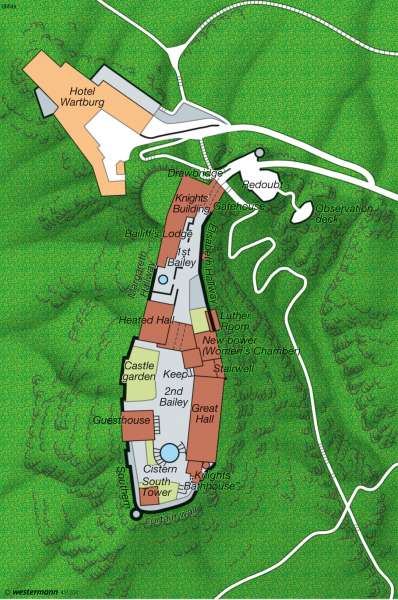Wartburg (Thuringia)
Europe - The modern age
978-3-14-100790-9 | Page 32 | Ill. 2

Information
For many Germans the Wartburg is seen as a model example of a castle complex and at the same time as a national monument that recalls various key moments in German history. In the 13th century Saint Elizabeth of Thuringia lived in the castle for some years; in 1521 Martin Luther translated the New Testament into German there; in 1817 and 1848 two legendary Wartburg festivals were held, at which students took up opposition to reactionary ideas. Since 1999 the Wartburg, which overlooks the town of Eisenach, has been a UNESCO World Heritage Site; every year some 400,000 visitors come to obtain their own impression of the defensive complex. After their ascent, they are greeted by a mix of architectural styles with buildings from the Romanesque, Gothic, Renaissance and Historicism.History
According to legend the foundation stone of the Wartburg was laid in 1067; it is mentioned for the first time in a document dating from 1080. Until 1247 the castle was the seat of the Ludovingians, after which it came into the possession of the House of Wettin. In the 15th century the complex, which was never destroyed during a siege, suffered a loss of importance, with the result that the buildings erected in the ensuing period were less magnificent.
The Wartburg enjoyed a revival in the 19th century, when it had become fashionable to romanticize about the past. From 1838, Grand Duke Carl Alexander of Sachsen-Weimar-Eisenach had the Wartburg restored. In Hugo von Ritgen he found a suitable architect, who devoted himself to the Wartburg project until his death in 1889. Since 1922 the maintenance of the castle has been in the hands of the Wartburg Foundation.
Architecture
Visitors approach the castle from the north. Firstly they enter the Vorburg (front castle), which is enclosed to the west by the Margareth Hallway and to the east by the Elizabeth Hallway, two closed battlement parapets. These, as well as the Vogtei (Bailiff's lodge) and the Knights' Building date from the 15th century.
The middle of the Wartburg between the front and main castles is dominated by the Neue Kemenate (New Bower) and the Dirnitz (Heated Hall Building). Both buildings date from the phase of restoration in the 19th century and present themselves in the Historicist style. Also dating from this epoch is the Bergfried (Main Tower), which marks the highest point of the Wartburg.
In the second bailey stands the Gadem, built in the 19th century. This was originally a guesthouse, but today it houses a café. At the southern end is the South Tower from the 14th century, which is the only surviving tower from the Middle Ages. But the most striking building of the Wartburg is the Palas or Great Hall. The construction of this representative residence for the landgraves began in 1155. Today — with the exception of numerous churches — the Palas is regarded as the best-preserved Romanesque building north of the Alps. The Knights' Bathhouse at the southern edge of the castle grounds does not have any long history to look back on; it was not built until 1889/90.
D. Falk; Ü: J. Attfield




